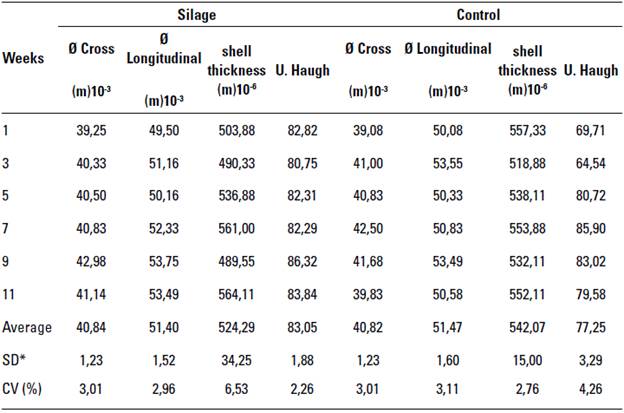INTRODUCTION
World fish production has shown sustained growth in recent decades, reaching 171 million tons in 2016, of which 86% was for direct human consumption (FAO 2018). In Colombia the fish farming sector in 2017 showed a growth in production of 9% with a total of 120,230 tons, with the red tilapia species contributing the most (62%), followed by white cachama (16%), silver tilapia (14%), trout (5%), and other species (3%) (Ministerio de Agricultura 2017) . This growth is accompanied by an equivalent volume of waste, which can cause significant environmental impacts as it represents between 60-70% (w/w) of total production (Martínez-Álvarez et al. 2015; Suarez et al. 2018). Despite being important sources of protein, this waste is most often discarded without any attempt of recovery. However, this waste can be used for animal feed, to obtain fishmeal, fats, or fertilizers, among other uses (Chalamaiah et al. 2012).
One of the processes for the recovery of nutrients from fish by-products that is currently in use is silage (Suarez et al. 2018) . This process involves the addition of acids, enzymes or lactic acid bacteria to the raw fish or its parts, causing a decrease in pH and liquefaction of the mass by the effect of endogenous enzymes, which act under acidic conditions (Fernández Herrero et al. 2013). The product obtained is a paste-like semi-liquid, greyish brown in color, with a characteristic fishy smell. This product provides partially hydrolyzed proteins, with nutritional properties very similar to those of the fish from which it is derived (Botello 2010).
The poultry industry is one of the fastest growing and most flexible of all livestock sectors. Driven primarily by strong demand, it has expanded, consolidated, and globalized over the past 15 years in countries at all levels of development (FAO 2013). However, the high cost of poultry feed is one of the main problems in the production chain, since approximately 95% of it is used to meet protein and energy needs, with fishmeal and soybean cake being the main sources of protein and cornmeal the main source of energy (Ravindran 2013). Egg is one of the most complete and easily accessible foods of animal origin. However, establishing the specifications and quality control of eggs for human consumption is not an easy problem to solve, since it involves numerous factors, diet being one of the principals (Andrade-Yucailla et al. 2015). Therefore, the objective of the present work was to evaluate the effect on egg quality parameters of the inclusion of chemical silage from red tilapia viscera (Oreochromis sp.) in diets for laying hens of the Isa Brown breed.
MATERIALS AND METHODS
The red tilapia viscera (Oreochromis sp.) were supplied by the El Gaitero fish farm, located in the municipality of San Jerónimo, Antioquia (Colombia). Immediately after gutting, they were taken to the laboratory, where they were defatted by heating them to 67°C for 30 minutes, letting the temperature drop to 45°C, decanting the fat, and then freezing them (-18°C) for 24 hours. This achieves a better oil separation, as the phases solidify separately (Arias et al. 2017). Subsequently, the lipid phase was separated from the frozen watery phase (rich in protein). The latter was crushed by a blade mill to homogenize it, then mixed with 0,03% sulfuric acid at 97% (Merck, Germany) and 1,16% formic acid at 85% (Merck, Germany) to start the hydrolysis and acidification process. Subsequently, BHT (Butylated hydroxytoluene) (Tecnas S. A., Colombia) and potassium sorbate (Tecnas S. A., Colombia) were added as antioxidant and preservative, respectively. Finally, the mixture was stored at 25°C for a period of 8 days. During this time the product was homogenized through agitation and pH checks were made every two days until it stabilized.
Bird feeding
In this study, 56 16-week-old laying hens (Gallusgallus domesticus) of the breed Isa Brown were randomly divided into two equal groups called control (DC) and silage (DE), which were further subdivided into 7 groups with 4 birds each, which were fed from week 16 to week 32. The isoproteic diets were developed following the nutritional requirements established in the Brazilian tables for poultry feeding (table 1) (Rostagno et al. 2011). The DC group was fed with a diet in which protein source was conventional materials such as fish meal and soybean cake, while the DE group was fed with a diet that contained 42% of the protein from red tilapia (Oreochromis sp.) silage. The birds were fed twice at day (morning and afternoon) with a 90 g/ day ration for each bird, and a constant supply of water.
TABLE 1 Composition and bromatological analysis of the diets
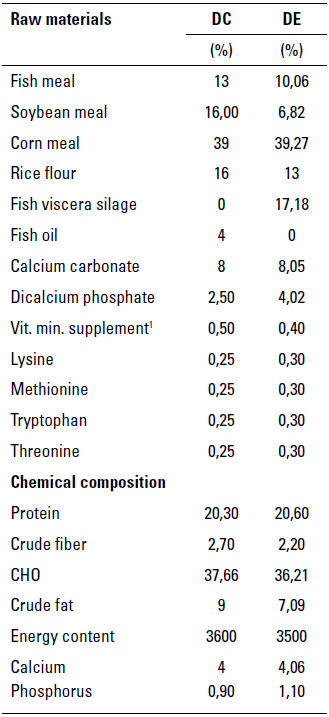
1Mineral vitamin supplement (composition per 250 g of product): vit. A - 1.400.000 IU; vit. B1 - 500 mg; vit. B12 - 300 mg; vit. B2 = 500 mg; vit. B6 - 1,6 g; vit. D3 - 2.500.000 IU; vit. E - 6000 IU; vit. K3 = 1000 mg; biotin - 30 mg; niacin -12 g; folic acid - 1 g; cobalt - 50 mg; Copper - 3000 mg; Iron - 25 g; Iodine - 500 mg; Manganese - 32,5 g; Selenium - 100,50 mg; Zinc - 22,49 g
Source: self-made.
Ethics committee approval
This research was approved by the Ethics Committee for Animal Experimentation of the Universidad de Antioquia (Act. 103 May 10-2016).
Physical-chemical and microbiological analysis
The physicochemical characterization of the silage and the eggs was done according to specifications established by the AOAC (Association of Official Analytical Chemists) (2000). The moisture content was determined by the methodology set out in standard 930,15 by drying the sample at 105°C for 8 hours. The protein was determined by the Kjeldahl method, standard 954,01. The ashes were analyzed according to standard 942,05. The fat was analyzed according to standard 920,39. The carbohydrate determination was carried out by subtracting the other components mentioned above from 100% of the sample (Spanopoulos-Hernandez et al. 2010). The physicochemical analyses of the eggs were carried out at the 2nd and 4th week of laying.
The microbiological analyses were determined according to the Colombian Technical Standard NTC 3688 (ICONTEC 1999), which establishes the analysis of aerobic mesophilic, total and fecal coliforms, Salmonella spp. Clostridium sulphite, reducing spores and molds and yeasts for this type of substrate.
Egg quality assessment
Different analyses of some components were carried out to determine the quality of the egg, which are described below.
The egg weight was determined by means of a 1 g precision analytical scale, model TxB220-1L (Shimadzu, Japan). Weights were measured daily for 13 weeks. The shape and symmetry of the egg was determined by measuring the longitudinal and transverse diameter, using a vernier caliper (Guerra Morales & Molina Díaz 2016). Haugh units are an international measurement for determining egg quality and freshness by relating egg weight in grams (p) and albumen height in millimeters (h). Based on these measurements, the units are calculated from the following equation (Suárez-Cardoso et al. 2016):
UH = 100 log (h - 1,7p 0,37 + 7,6)
Shell thickness was determined using a 0,0001 mm precision digital micrometer (Surtek, China). Shell hardness was determined using an EZ-SX texturizer (Shimadzu, Kyoto), using a 500 Newton (N) load cell and a speed of 100 mm/min until complete breaking of the eggshell was achieved.
RESULTS AND DISCUSSION
Bromatological composition of the silage
Table 2 presents the proximal composition of the viscera and its silage. The protein and lipid composition of the viscera is typical for this species (Arias et al. 2017; Suarez et al. 2018). On the other hand, the values in the silage tend to be higher than those found for acid silage from freshwater fish waste with 44,38% protein on dry basis (Vidotti et al. 2003) and that of organic tuna silage (Thunnus albacares) with 30,52% crude protein (Spanopoulos-Hernandez et al. 2010).
TABLE 2 Bromatological composition of the viscera and viscera silage from red tilapia (Oreochromis sp.)
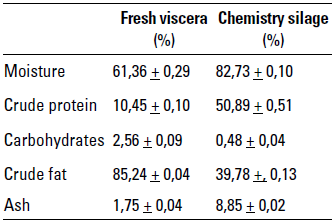
Source: self-made.
Regarding the silage, the typical characteristics were obtained with a semi-liquid paste-like consistency, a greyish brown color, and a characteristic fishy smell (Botello 2010; Suarez et al. 2018). Its nutritional composition makes it an ideal input for animal feed (Botello 2010). Proteins and lipids from tilapia silage residues have been used for feeding mainly herbivorous and omnivorous species, with satisfactory results, being used as a partial substitute for fishmeal (Goosen et al. 2014; Güllü et al. 2014), which is the most widely used source of animal protein in animal feed, precisely because of its digestibility and protein content (Chalamaiah et al. 2012). Thus, this research is part of the current trend of evaluating the effects of using mixtures from fish sources to reduce the environmental impact generated by fish farming (Smárason et al. 2017; Suárez et al. 2018).
For the DE diet, 43,4% of the wet chemical silage was included. This was a considerable fraction of the formulation, which corresponds to 17,8% on dry basis; this percentage represents a substitution of 57,37 and 23% of soybean cake and fishmeal, respectively. Different studies have used values around 15% of silage with similar physicalchemical parameters of protein and fat, in tilapia feed (Llanes et al. 2010), which is important to highlight because in this case the use of silage would be maximized.
On the other hand, the microbiological evaluation of the chemical silage is shown in table 3. These values are within those established by the Colombian Agricultural Institute's guidelines for raw materials and inputs for animal feed (ICA 1999), which indicate that chemical silage from tilapia viscera can be used as an input in the preparation of feed for ISA Brown line laying hens without causing any condition or pathology.
TABLE 3 Microbiological characterization of the red tilapia (Oreochromis spp.) viscera silage
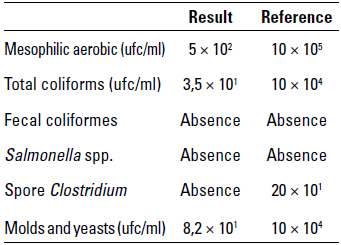
Source: self-made.
Figure 1 presents the behavior of egg weight as a function of time for the two diets evaluated. It is observed that in the first 11 weeks of laying the egg weight had no statistically significant difference between the DC and DE diets (P > 0,05). In both the weight presents a constant increase as a function of time. Same result has already been reported by Padhi et al. (2013), who concluded that the egg increases in weight until week 52. Between week 12 and 13 the silage diet achieved a significant increase (P < 0,05) in egg weight over the control diet. Similar weights were obtained by Batalha et al. (2018), who used a lower silage substitution, which may indicate that using higher concentrations of silage does not significantly affect the weight of eggs over time, on the contrary, this substitution could favor it, mainly because of the quality of lipid levels in the diet, since yolk formation and laying depend significantly on energy and lipid levels in the ovary (Chen 2003; Coorey et al. 2015; Zhou et al. 2008).
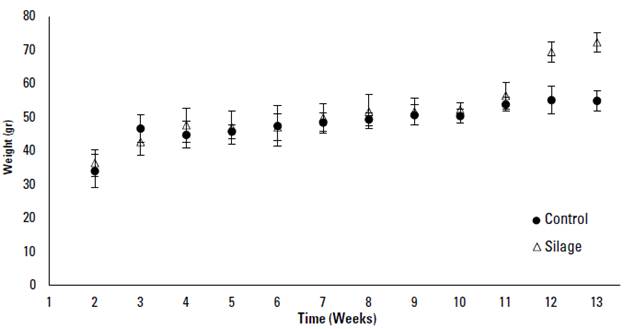
FIGURE 1 Egg weight as a function of time during feeding of ISA Brown line laying hens (Gallus gallus domesticus) Source: self-made.
Table 4 shows the longitudinal and transverse diameters of the eggs for both diets as a function of time. Longitudinal and transverse diameter are directly associated with egg weight, i. e. heavier eggs tend to have larger diameters and vice versa (Andrade-Yucailla et al. 2015). This trend was observed in the last weeks of experimentation, in which eggs from the group of hens fed the silage diet, which have heavier eggs, and larger transverse and longitudinal diameter measurements compared to eggs from hens fed with the control diet (53 x 10-3 m vs. 50 x 10-3 m). These results coincide with those reported by Garcia Moreno et al. (2016). These authors reported that the productivity of the commercial layer is influenced by body weight, which affects not only the number and weight of eggs, but also their size distribution (Garcia Moreno et al. 2016). Similar results were reported by Juárez-Caratachea et al. (2010), who determined the egg quality in Michoacan-México, obtaining transverse and longitudinal diameters from 53 x 10-3 m to 58 x 10-3 m, and 40 x 10-3 m to 43 x 10-3 m, respectively (Juárez et al. 2010).
Another variable in the egg quality is the shell thickness (table 4). This variable is used as an indicator of quality in the egg (Stadelman et al. 1995) because it supports and preserves the other structural parts of it. Likewise, it is the first physical protection barrier against mechanical damage (Nys & Guyot 2011). This variable did not present significant statistically differences (P < 0,05) between the two study groups, indicating that the substitution of protein raw materials by silage from red tilapia viscera did not cause any effect on the thickness of the shell, coinciding with what was reported by Silva et al. (2017), who did not find significant differences in this variable. In their study, they replace soybean cake with fish waste meal in a proportion of 1 to 4%. However, these results were lower than those of the present study (382 x 10-6 m vs. 564 x 10-6 Lim).
Haugh units (table 4) are an important indicator of egg quality. They are used as an index of freshness in the egg. A higher value of this parameter indicates a higher freshness index (Instituto de Estudios del Huevo 2009). Table 4 shows the values obtained from Haugh units in this study, according to diet and laying weeks. There were statistically significant differences regarding diet (p < 0,05), with silage diet values being higher than those found for the control diet. This indicate that the inclusion of chemical silage from red tilapia viscera presented a beneficial effect on this quality variable, indicating a higher level of freshness. Similar data was reported by Batalha et al. (2018), using different levels of Pirarucu silage substitution (0,3 to 3%), without presenting statistically significant differences with the increase in silage substitution (Batalha et al. 2018), which can be corroborated in this study where a 17,8% substitution was used.
Figure 2 shows the behavior of shell hardness as a function of time, for the two diets studied. There were no statistically significant differences (p < 0,05) between the two diets, nor in each of them over time. These values are within the theoretical ranges established in several studies, such as the one carried out by Guard-Bouldin et al. (2006) and Clerici et al. (2006), who reported shell hardness values between 30 N to 41 N for both studies (Clerici et al. 2006; Guard-Bouldin & Buhr 2006).
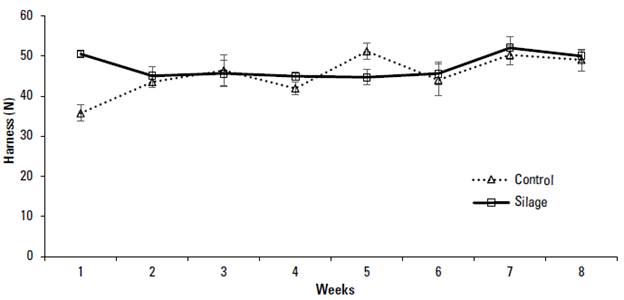
FIGURE 2 Egg hardness as a function of time during feeding of ISA Brown line laying hens (Gallus gallus domesticus) Source: self-made.
TABLE 5 Composition and bromatological analysis of the egg according to diet
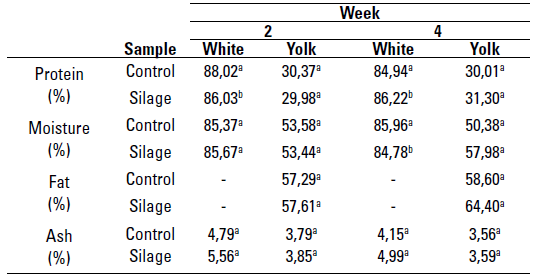
Source: self-made.
Means within a row for experimental samples without a common superscript differ (P < 0.05).
Regarding the physicochemical composition of the egg white and yolk (table 5), where different letters in the same column indicate the presence of statistically significant differences (p < 0,05) between the two diets evaluated, it was observed that only the protein variable of the egg white presented statistically significant differences (p < 0,05). This is similar to the results reported by Seibel & Souza-Soares (2004), whose study was carried out using fish silage in percentages that varied between 5 and 10% in quail feeding. However, these authors obtained higher protein values compared to those found in this study (94% vs. 88%). On the other hand, in the control and silage groups (table 5), an increase of 57 to 64% in the concentration of fat in the egg yolk was observed in favor of the silage group, which indicates that this may favor the synthesis of lipids for egg yolk formation (Seibel & Souza-Soares 2004). However, other authors such as Anderson (2013) and Toyes Vargas (2016) found values lower than those found in this study for fat in white and brown chicken egg yolks, with results between 35 and 40%, respectively. These differences may be due to the type of viscera and processes used to obtain the silage, which was made from squid and hatchet fish. However, it is important to mention that laying birds require twice as many lipids in the liver to promote yolk formation and thus the increase in egg laying (Chen 2003; Coorey et al. 2015).
On the other hand, according to table 5, the crude protein level in the yolk was 30,37 and 29,98% for the control and silage group, respectively. These two diets did not present significant differences (p < 0,05) in the weeks of the analysis. However, these results contrast with those of Grobas & Mateos (1996), who obtained higher protein values between 49 and 46% in laying birds. Regarding the ash, around 4% for both groups (table 6), this result is consistent with other authors such as Benjumea (2010) y Ramirez et al. (2013), who obtained similar values in feeding Hy-Line-Brown and quail line laying hens, respectively.
CONCLUSIONS
Chemical silage from red tilapia (Oreochromis sp.) viscera has the necessary bromatological and microbiological characteristics to be used as a protein input in the design of diets for laying hens. The use of this silage in the feeding of ISA Brown line laying hens does not affect the quality parameters of the egg, which indicates that it can be used as an alternative input to conventional protein raw materials such as fishmeal and soybean cake.













